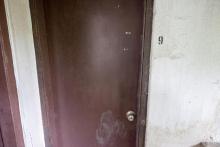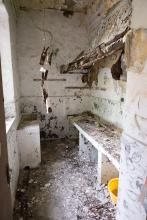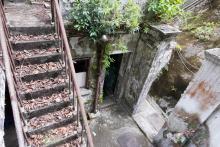Marble Hall Gatekeeper's Lodge [1901- ]
Primary tabs
The site of No. 1 Conduit Road is composed of a block of 20-storey government quarters (30-40 years old) and a two-storey pitched-roof building (hereafter, “the building”). Historical records show that the building was built as the Gatekeeper’s Lodge (守衛室) of Marble Hall (雲石堂) which was the private residence of Sir Paul Chater (遮打爵士) (1846-1926), a Calcutta-born Armenian merchant of great wealth.
The Gatekeeper’s Lodge was probably built in 1901/1902 when Marble Hall was built but in any case no later than 1918, when it appears in a site plan prepared by the Director of Public Works. Located at a site some 500 feet above sea level, Marble Hall was executed in marble specially quarried in Italy and Greece and polished in Belgium. It has been regarded as one of the finest buildings ever constructed in Hong Kong. It stood on a site where the above-said block of government quarters stands today. The main building of Marble Hall has disappeared, but the photos enclosed to the Colonial Office files reveal how palatial and sumptuously furnished a home it once was.
Sir Paul Chater was a multi-layered and rich personality in Hong Kong. He had a finger in different kinds of profitable pie – wharfing, electricity, trams, ferries, banking, hotels and land. He served as an appointed unofficial member of the Legislative Council for nearly 20 years. He presided over the Jockey Club for many years. He funded the construction of St. Andrew’s Church in Kowloon and the clock tower of the HKU Main Building. He donated his private art collections to Hong Kong Government. Sir Paul Chater’s will stipulated Marble Hall be bequeathed to Hong Kong Government upon the death of his wife. After she died in 1935, Marble Hall became the colony’s “Admiralty House” – the official residence of the Naval Commander-in-Chief – until World War II when the Japanese took it over.
In May 1946 Marble Hall was devastated by a fire. It stood empty until it was demolished in 1953 to make way for redevelopment, leaving the Gatekeeper’s Lodge as the only reminder of Chater’s residence. Shortly after World War II, the Gatekeeper’s Lodge was leased to the Royal Interocean Lines for use. Later on, the Government took it over and used it as government staff quarters. Before 2000, it was used by the now-defunct Urban Services Department (USD) as staff quarters. It was called “Marble Hall USD Staff Quarters” in the 1990s, then “Chater Hall Gardener’s Quarters”. Until recent times, the building has been partially used for storage by landscape staff and partially vacant. Nowadays, it is totally vacant.
The building falls on a triangular site opposite the 20-storey government quarters to its south and Botanic Terrace (芝蘭台) to its north. It is elevated above the level of Conduit Road on a platform cut into the hillside supported by stone retaining walls built of layers of granite blocks. The granite walls form a habitat for trees whose roots sprawl densely on the wall surfaces, providing a means of anchorage. The entrance way is built of a grand flight of granite steps. The building is a two-storey Chinese tiled pitched-roof structure. Typical architectural features include a verandah with iron railings, expressed rainwater pipes and a chimney stack to serve the kitchen. The exterior wall of the building facing Botanic Terrace is of painted brickwork with regular rows of casement windows at each floor level. Many of the original doors and louvered timber shutters still remain. The use of Chinese tiles for the pitched roof supported on timber frame is a local adaptation.
The building bears witness to Chater’s residence and should be preserved if at all possible as a very fine example of this form of architecture in its setting. It has built heritage value, giving us a glimpse of the past. As far as can be seen there have not been any major alterations so that the building retains its authenticity. At least one window frame has been replaced with aluminium one, but this alteration may be reversible.
The building and its immediate environs are of considerable social value and local interest. Clearly associated with Sir Paul Chater’s home, the building gives us a glimpse of the past. The stone walls with old trees growing on them contribute to the landscape character of the area. The graded historic buildings nearest to it include Hong Kong Catholic Cathedral of the Immaculate Conception (天主教聖母無原罪主教座堂) at No. 16 Caine Road and Jamia Mosque (清真寺) at No. 30 Shelley Street. If the building is to be saved an appropriate adaptive re-use needs to be found which would showcase it to the public and also to tourists as an image of old Hong Kong.





Comments
re: Chater Hall Gate House
This is a new addition to the AAB's list of graded buildings. They're proposing Grade II. Photos here:
http://www.lcsd.gov.hk/CE/Museum/Monument/form/7_new_item_photos.pdf
Chater Hall Gate House
I went to see this building when I was last in Hong Kong. If it would help, I would be happy to lend my name and support to anything that would enable the building to be saved.
Best wishes
Liz Chater
re: Chater Hall
Hi Liz, I'm sure the Antiquities Advisory Board would love to hear from you, especially with any further information on the building (or Marble Hall itself) or thoughts on its use. The building is - I guess- owned by the government so there should be no problems with preserving it. It could be used to showcase Chater's life, given the few monuments to his contribution to Hong Kong still left, as well as Marble Hall. They're seeking comments at the moment:
From now until 31 October 2010, members of the public are invited to express their views on the assessment results of 7 new items and/ or provide additional information on the concerned buildings, if any, by writing to the Antiquities and Monuments Office via:
2208 4400
Gate Keeper's Lodge
Thanks 80sKid. I shall write to the Antiquities and Monuments Office today.
re: Gatekeepers House
That's great. It is owned by the government, because of course your ancestor Sir Paul bequeathed it to them. I hope they will do something useful with it (and look after it better than they did Marble Hall!), though the spot is an awkward one to get to.
Gatekeepers Lodge
Well, I have written to them with my thoughts, so let's see what happens!
Liz
right at the top of the escalator
I just sent this in:
Dear AMO,
I write to suggest that the Chater Hall Gatekeepers Lodge be used as a museum for displaying information about Marble Hall, donated by Chater to the Government.
The building is right on the tourist trail. Innumerable tourists have stopped me at the top of the escalator and asked how to walk to the Peak. I send them on to Hornsey Road - and the Chater Gatekeepe's Lodge is just a steep 1/2 block away from the intersection with Conduit Road.
This would be an ideal use of the building - and selling books, postcards etc. could help fund it.
nearby Hidden gem - playground
Right next door (uphill) is a nice big open playground. A hidden gem if you've never been there. It is called the "conduit road service reservoir playground"
Conduit Road Service Reservoir
.....and Chater owned the reservoir which was at the back of his house......there, more useless information!
Swedish girl makes good
Liz, your website need updating now that newspapers are going online - http://www.google.co.uk/search?hl=en&q=%22lady+chater%22&sa=N&tbs=nws:1,ar:1
Lady Chater - here is one that claims that Lady Chater went to Seattle about one year after her brother, a barber, in 1889.
Re Swedish girl makes Good!
Hi annelisec, thanks for that. I actually know all this already. I have a very detailed bio on her but I just haven't put it on my website, as i'm holding it back for the book, but please do keep things coming as and when you find them as I really do appreciate you and others thinking of me and my research.
best wishes
Liz
6.5 years later...
It's been 6.5 years after it was listed as Grade 2. I believe comments from many people were received by the AMO related to this Marble Hall Gatekeeper's Lodge. I went there yesterday, sadly, it is still an abandoned house!
Site visit 2015
I've added pictures of a site visit a couple of years ago.